-

The back porch view shows the shallow width of Dead Man's Island. The bay side of the island has narrow dune formations. Sea grasses and trees are the vegetation on the channel side of the island.
-

-

-
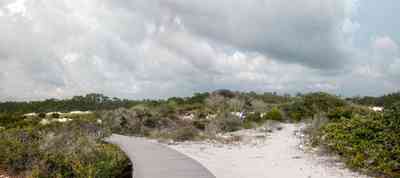
-
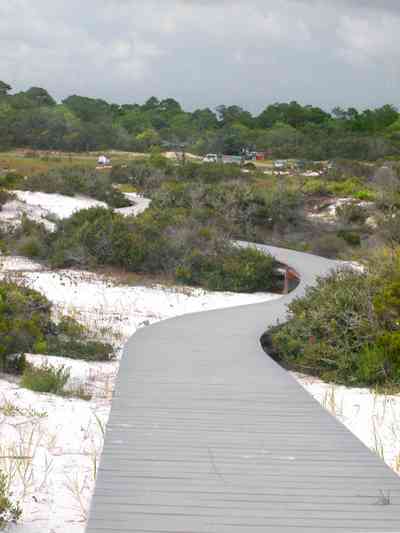
-

A diversity of gulls, terns and various shorebirds can be found year-round feeding at the shore.
-

The initial step in restoration of deflated sand dunes is to use structures that can accumulate sand. Dune building fences can be erected in order to trap sand and reconstruct new dunes.
-

Beach elder (Iva imbricata) has sparse, woody, upright stems and fleshy narrow bright green leaves. Small lavender flowers occur in late summer. Beach elder accumulates sand rapidly and produces low rounded dunes.
-

-

-
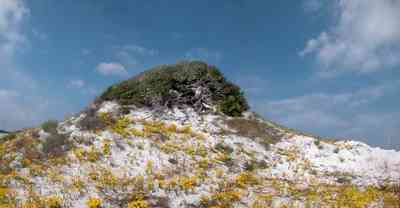
-

-

-

The road to the fortifications bisects the narrow barrier island.
-

-

-

-

-

-

-

-

-

-
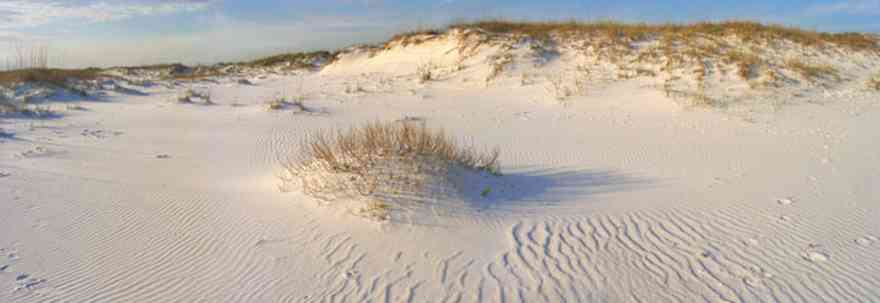
The dune formations are more massive than those in the center of the island. This area is isolated from many of the public beach sites.
-
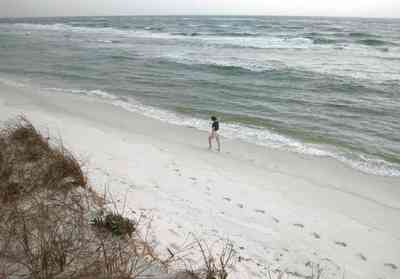
Dunes at the end of the island rise high above the waves.
-

-

The yellow flowering plants in the foreground are Woody Goldenrod (Chrysoma pauciflosculosa) of the Sunflower Family. (source: Searcy, Darryl. Botanist)
-

The yellow flowering plants in the foreground are Woody Goldenrod (Chrysoma pauciflosculosa) of the Sunflower Family. (source: Searcy, Darryl. Botanist)
-

The yellow flowering plants in the foreground are Woody Goldenrod (Chrysoma pauciflosculosa) of the Sunflower Family. (source: Searcy, Darryl. Botanist)
-
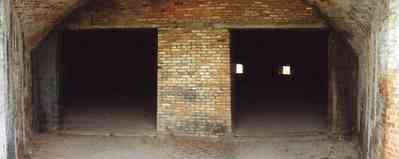
The yellow flowering plants in the foreground are Woody Goldenrod (Chrysoma pauciflosculosa) of the Sunflower Family. (source: Searcy, Darryl. Botanist)
-

The yellow flowering plants in the foreground are Woody Goldenrod (Chrysoma pauciflosculosa) of the Sunflower Family. (source: Searcy, Darryl. Botanist)
-

-
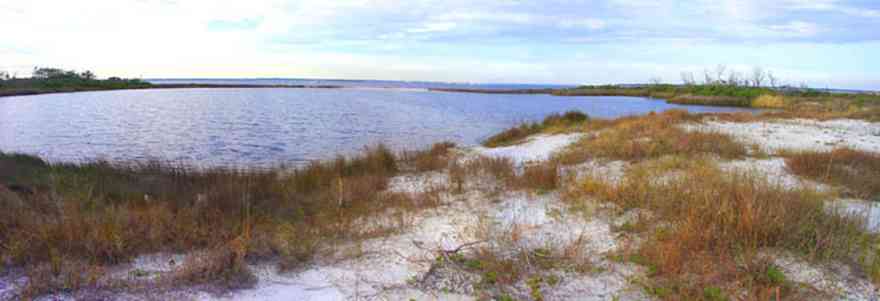
The small lake is approximately seven acres in size. It borders Escambia Bay.
-

The lake is bordered by sand dunes and marsh grass. It is located about 2 miles from the main gate of Fort Pickens on the north side of the road.
-

The ranger house at Fort Pickens is the welcome area for the National Seashore.
-

The building was formerly used as the Coast Guard Station.
-

This view of the Ranger Station is taken near the wreck of the Norweigan bark, the Catherine, which is located in 15 feet of water where it sank on August 7, 1894. The outline of the vessel can be seen as a dark shadow on the surface.
-

The northern facade of the building faces Fort Pickens Road.
-

The boardwalk can be seen from the interior of the building.
-

Battery Langdon is directly across Fort Pickens Road from the shelter and walkway leading to the gulf.
-

The boardwalk begins at the parking lot and ends over the ridge of dunes.
-

The southern facade of the building faces the gulf.
-

-

-

-
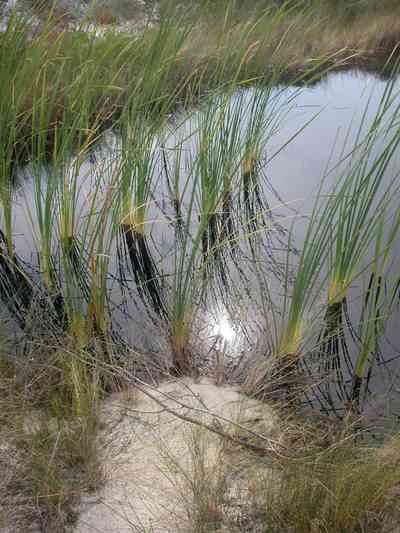
-

The fence is located at the Opal Beach sign, three miles from the Opal Beach boardwalk.
-
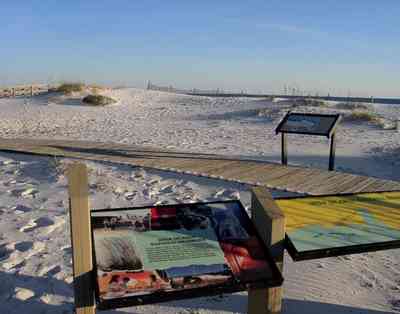
This is one of the entrance walkways to the picnic area at Opal Beach.
-

There are a number of picnic shelters at the beach service area.
-

The fence on the right of the photograph is put in place to promote dune formation.
-

The walkway leads through the dunes to the beach.
-

-

-

-
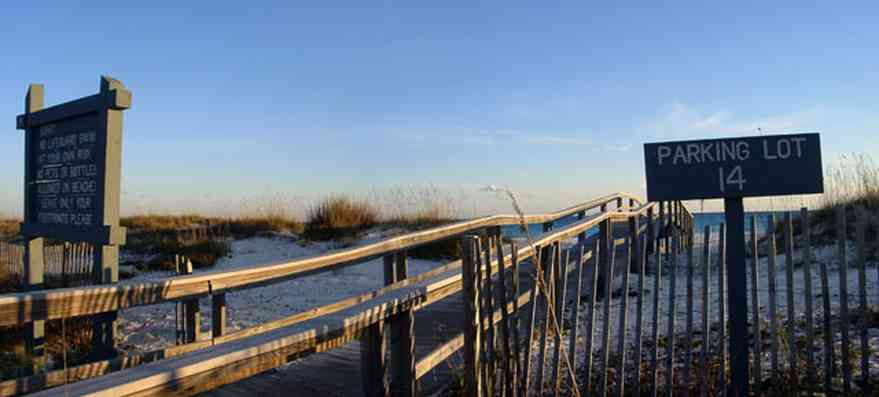
The boardwalk is typical of the crossovers at parking bays along the coast.
-

This is a short run boardwalk from the parking lot over the dunes.
-

Boardwalks aid beach preservation by making a path to the water and lessening impact on the dune formations.
-
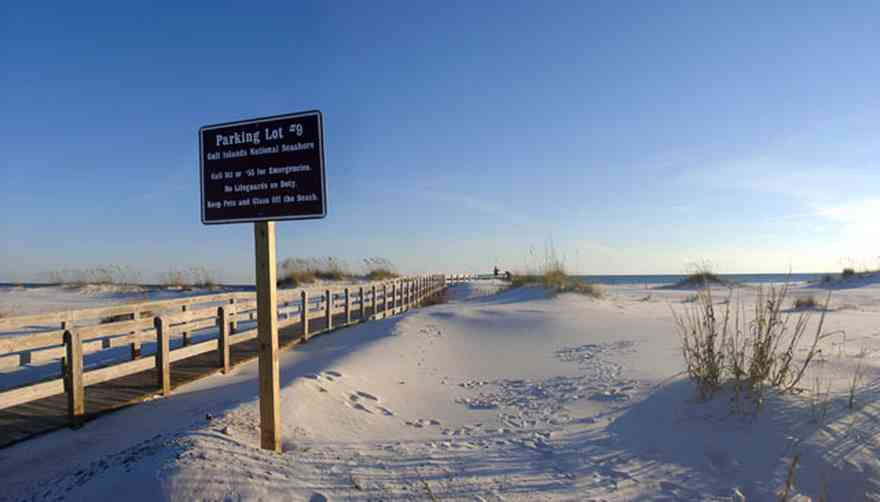
The national seashore maintains boardwalks and parking bays along Via de Luna Drive on Santa Rosa Island
-

The boardwalk aids in the formation of its own dune alongside of the walkway.
-

The boardwalk ends in a larger staging area across the dunes.
-

-

-

The boardwalk leads from Johnson Beach Road to the Gulf.
-

There is little wave action on the sound side.
-

-

There is a boardwalk on the Gulf side of the turn-around leading to the beach.
-

For nature lovers, the park is a good place to begin an exploration of the barrier island ecosystem.
-

-

-

-

-

-

-

-
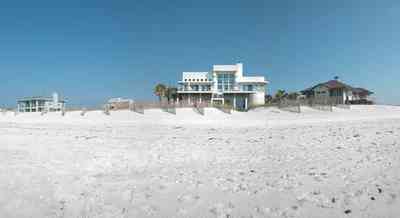
There is a wide expanse of beach between the waterfront and the home.
-

Every room has the advantage of a large expanse of windows or skylights on both floors.
-

Dunes on the side and front are held in place by the extensive root system of sea oats.
-

A boardwalk leads from the backporch to the beach.
-

The view is facilitated by glass balcony railings. The fence on the beach is a dune building line trap the blowing sand.
-

The house was rebuilt in 1995. Stainless steel trim and hardware were added to the exterior finishing.
-

The second floor deck wraps around the house and is an extension of the interior living space.
-

A hot tub is sunken into the deck off the master bedroom.
-

The staircase bisects the deck leading to the downstairs living area.
-

-

There is an enclosed patio area on the east side the house.
-

The home faces north on Ariola Drive.
-

The glass brick tower is the dominant feature of the facade. It functions as the enclosure for the circular staircase.
-

Stucco is the exterior finish of the home.
-

A circular staircase connects the guest quarters to the second floor residence.
-

The risers are wood that match the upstairs flooring material.
-

-

The kitchen is located on the west side of the second floor. It features a catering kitchen and wine cooler.
-

The appliances were imported from France.
-

Santa and his helpers enjoy refreshments.
-

Tom Roush stands atop a dune formation.
-

The beach road bisects Santa Rosa Island.
-

The dunes form undulating ridges along the north side of the beach road. This area is across the road from Parking Lot 10 at the Gulf Islands National Seashore.
-

Sparse vegetation holds the dunes in place.
-

Some of dune formations on the north side of the beach road rise to a height of about 30 feet.
-

The Gulf can be seen on the far right of the photograph.
-

Beach grasses have long roots that form a subsurface net, keeping the dunes from disintegrating.
-

Beach elder accumulates sand rapidly and produces low rounded dunes.
-

Beach elder (Iva imbricata) has sparse, woody, upright stems and fleshy narrow bright green leaves. Small lavender flowers occur in late summer.
-

East Park is located at the farthest point within the jurisdiction of Escambia County. It is adjacent to the Gulf Island National Seashore.
-

This is the west gate of the park. The shelter and bathhouse area is to the far left of the parking lot.
-

-

-

The new pier is a replacement for the old wooden structure which was destroyed during Hurricane Opal.
-
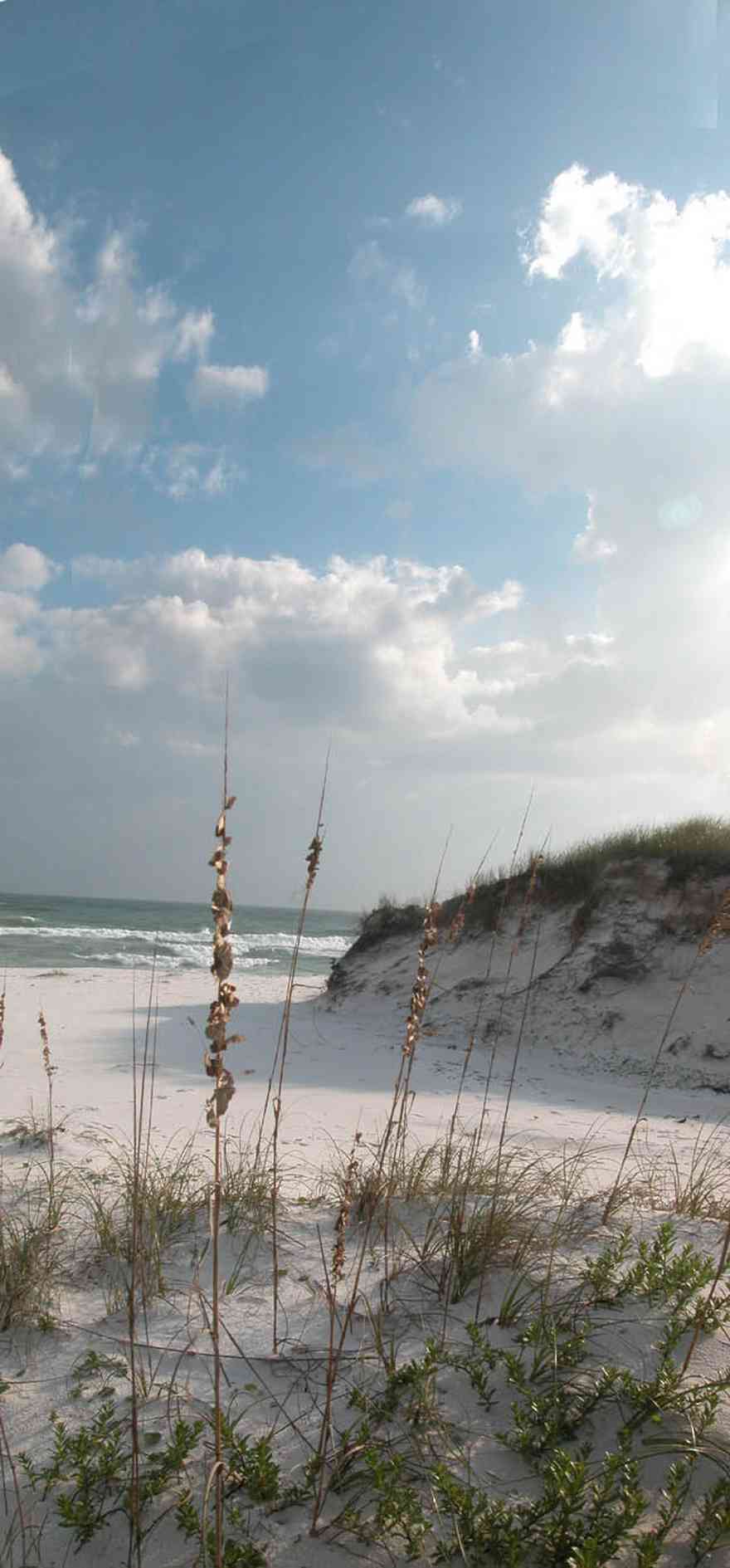
Breaking waves run up on wide, sandy beaches against a backdrop of large sand dunes topped with a smattering of sea oats.
-

Atop and just behind the dunes lies an intriguing habitat that supports a limited but interesting array of plants and animals.
-

Deep white sand is so fine that the beach below you squeaks when you walk. Its seaward edges borders deep green and blue water.
-

-

-

-

Sea oats are the preferred landscaping element at the beach.
-

-

-

-

-

-

The road bisects Santa Rosa Island.
-

The large dunes are located on the soundside or northside of the island.
-

The sparse vegetation has extensive root systems that hold the dunes in place.
-

Emerald water on the right of the photograph is on the gulf side of the island.
-

The seed heads mature in August.
-

Sea Oats provide long term protection against beach erosion and add natural beauty to coastal ecosystems.
-

The plants grow to 6 feet high and they function to trap wind-blown sands that eventually mound to begin dune formation.
-

The small lake is located on Sugar Bowl Lane and Via de Luna Drive on Santa Rosa Island. The area is known for its large dunes which shelter homes built on the soundside of the dune formations.
-

-

-

-

-
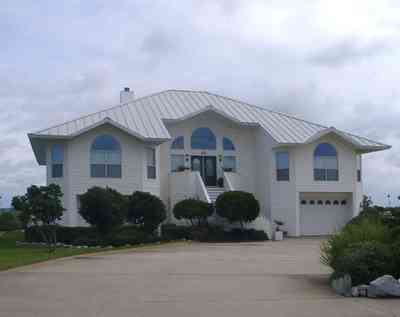
-

This photo features Sugar The Wonder Dog. Dogs are not allowed on the beach so it was a surprise to see a golden retriver playing in the sand.
-

Sea oats have a deep stem that may reach several feet below the surface of the dune. As the dune continues to grow, this stem send out vigorous branching rhizomes at or just below ground level. As a result a sea oat may reach to the very base of the dune that supports it with a laybrinth of rootlike structures.
-

The tall brown stalks that form wheat-like seed heads are called sea oats.
-

The modified branches of the sea oat insure that the plant captures an adequate water supply from the porous sand while at the same time staying firmly planted in position.
-

This aerial shows the road that goes the length of Santa Rosa Island. All beach areas can be reached by road, but the road can't be seen from the water.
-

The white sand actually traveled from the Appalachian mountains from local rivers. The dunes are tops with a smattering of sea oats.
-

The short fences were installed after recent storms to promote dune formation by trapping blowing sand.
-
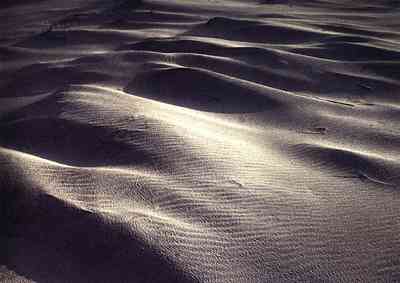
Some of the large dunes are likely the remains of ancient beach ridges that formed during a higher stand of the sea.
-

Summer is best for saltwater and beach ativities; fall, winter, and spring are best for birds.
-

A two lane road runs through the middle of the island.
-

This is the street view of a home located on Perdido Key Drive.
-
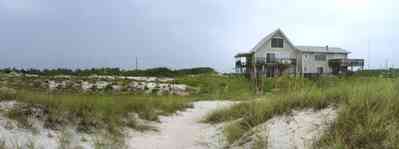
Dunes surround the house which faces south on the Gulf of Mexico.
-

The back porch of the home faces the Gulf of Mexico.
-

The home is surrounded by dunes. Sea oats, lichens and cacti are ground cover.
-
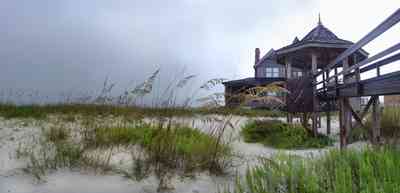
The facade of the house faces the Gulf of Mexico.
-

The home is isolated in the center of acres of native plants on low dune formations.
-

This is a southern view of the gothic beach house from the vantage point of Perdido Key Drive.
-

The gazebo overlooks the Gulf of Mexico on the beachfront.
-

The walkway extends from the house to the beachfront gazebo.
-

The home is located approximately 200 feet from Perdido Key Drive.
-

-

-

-

-

-

-

-

-
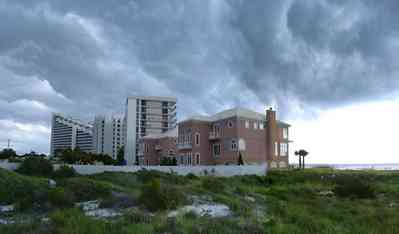
There are several large condo units located to the east of the gothic house on Perdido Key Drive.
-
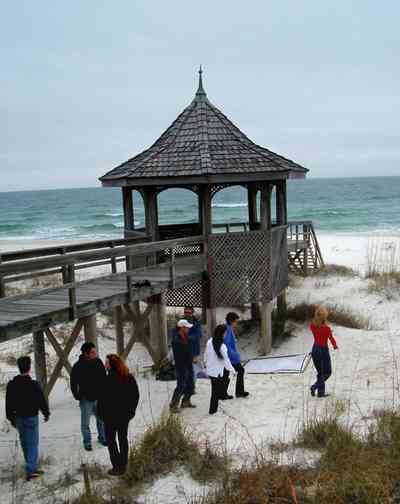
A photo shoot sets up near the gazebo. Wrangler Jeans choose the house as a location for its fall advertising campaign.
-

A Wrangler model poses under the boardwalk.
-

Photos from the shoot will be used to establish a point-of-puchase campaign at WalMart stores.
-

Barrier beaches are one of the world's most restless landforms. As can be seen above the tress are growing on shifting sand which looks like snow.
-

The sand pine forest is located on the sound side of the key on older dunes.
-

Ridges of old dunes form hills and valleys through the forest.
-

In contrast to the species of pine shown below, the sand pine is much shorter. Its form can be twisted with lower branches growing close to the ground.
-

The overstory in some locations is composed of an older growth of short-leafed pine tree.
-

Florida rosemary is a sand-loving evergreen shrub.
-
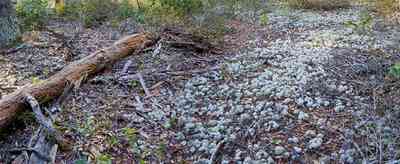
A variety of lichen and moss are the most common ground cover.
-

Pieces of pine scrub trees decay slowly because of the high content of sap.
-

The colors of Florida rosemary compliments the green lichens and mosses.
-

There is a distinctive dune formation between the park site and the beach.
-

The State of Florida operates two park sites along Perdido Key Drive.
-

Several walkways lead across the dunes to the beachfront. There is an ample parking bay adjacent to the area.
-

Boardwalks from the parking lot allow visitors to access the beach without causing damage to the fragile dunes and beach vegetation.
-

Visitors can view native plants and animals in the natural environment.
-

-

Coastal dunes are formed when sand is trapped around the stems, leaves and roots of plants in the vegetated areas of the beach.
-

These were taken just before the road was finished and then damaged again by Dennis.
-

There are few large dunes along the gulf side.

 The back porch view shows the shallow width of Dead Man's Island. The bay side of the island has narrow dune formations. Sea grasses and trees are the vegetation on the channel side of the island.
The back porch view shows the shallow width of Dead Man's Island. The bay side of the island has narrow dune formations. Sea grasses and trees are the vegetation on the channel side of the island.



 A diversity of gulls, terns and various shorebirds can be found year-round feeding at the shore.
A diversity of gulls, terns and various shorebirds can be found year-round feeding at the shore. The initial step in restoration of deflated sand dunes is to use structures that can accumulate sand. Dune building fences can be erected in order to trap sand and reconstruct new dunes.
The initial step in restoration of deflated sand dunes is to use structures that can accumulate sand. Dune building fences can be erected in order to trap sand and reconstruct new dunes. Beach elder (Iva imbricata) has sparse, woody, upright stems and fleshy narrow bright green leaves. Small lavender flowers occur in late summer. Beach elder accumulates sand rapidly and produces low rounded dunes.
Beach elder (Iva imbricata) has sparse, woody, upright stems and fleshy narrow bright green leaves. Small lavender flowers occur in late summer. Beach elder accumulates sand rapidly and produces low rounded dunes.




 The road to the fortifications bisects the narrow barrier island.
The road to the fortifications bisects the narrow barrier island.








 The dune formations are more massive than those in the center of the island. This area is isolated from many of the public beach sites.
The dune formations are more massive than those in the center of the island. This area is isolated from many of the public beach sites. Dunes at the end of the island rise high above the waves.
Dunes at the end of the island rise high above the waves.
 The yellow flowering plants in the foreground are Woody Goldenrod (Chrysoma pauciflosculosa) of the Sunflower Family. (source: Searcy, Darryl. Botanist)
The yellow flowering plants in the foreground are Woody Goldenrod (Chrysoma pauciflosculosa) of the Sunflower Family. (source: Searcy, Darryl. Botanist) The yellow flowering plants in the foreground are Woody Goldenrod (Chrysoma pauciflosculosa) of the Sunflower Family. (source: Searcy, Darryl. Botanist)
The yellow flowering plants in the foreground are Woody Goldenrod (Chrysoma pauciflosculosa) of the Sunflower Family. (source: Searcy, Darryl. Botanist) The yellow flowering plants in the foreground are Woody Goldenrod (Chrysoma pauciflosculosa) of the Sunflower Family. (source: Searcy, Darryl. Botanist)
The yellow flowering plants in the foreground are Woody Goldenrod (Chrysoma pauciflosculosa) of the Sunflower Family. (source: Searcy, Darryl. Botanist) The yellow flowering plants in the foreground are Woody Goldenrod (Chrysoma pauciflosculosa) of the Sunflower Family. (source: Searcy, Darryl. Botanist)
The yellow flowering plants in the foreground are Woody Goldenrod (Chrysoma pauciflosculosa) of the Sunflower Family. (source: Searcy, Darryl. Botanist) The yellow flowering plants in the foreground are Woody Goldenrod (Chrysoma pauciflosculosa) of the Sunflower Family. (source: Searcy, Darryl. Botanist)
The yellow flowering plants in the foreground are Woody Goldenrod (Chrysoma pauciflosculosa) of the Sunflower Family. (source: Searcy, Darryl. Botanist)
 The small lake is approximately seven acres in size. It borders Escambia Bay.
The small lake is approximately seven acres in size. It borders Escambia Bay. The lake is bordered by sand dunes and marsh grass. It is located about 2 miles from the main gate of Fort Pickens on the north side of the road.
The lake is bordered by sand dunes and marsh grass. It is located about 2 miles from the main gate of Fort Pickens on the north side of the road. The ranger house at Fort Pickens is the welcome area for the National Seashore.
The ranger house at Fort Pickens is the welcome area for the National Seashore. The building was formerly used as the Coast Guard Station.
The building was formerly used as the Coast Guard Station. This view of the Ranger Station is taken near the wreck of the Norweigan bark, the Catherine, which is located in 15 feet of water where it sank on August 7, 1894. The outline of the vessel can be seen as a dark shadow on the surface.
This view of the Ranger Station is taken near the wreck of the Norweigan bark, the Catherine, which is located in 15 feet of water where it sank on August 7, 1894. The outline of the vessel can be seen as a dark shadow on the surface. The northern facade of the building faces Fort Pickens Road.
The northern facade of the building faces Fort Pickens Road. The boardwalk can be seen from the interior of the building.
The boardwalk can be seen from the interior of the building. Battery Langdon is directly across Fort Pickens Road from the shelter and walkway leading to the gulf.
Battery Langdon is directly across Fort Pickens Road from the shelter and walkway leading to the gulf. The boardwalk begins at the parking lot and ends over the ridge of dunes.
The boardwalk begins at the parking lot and ends over the ridge of dunes. The southern facade of the building faces the gulf.
The southern facade of the building faces the gulf.



 The fence is located at the Opal Beach sign, three miles from the Opal Beach boardwalk.
The fence is located at the Opal Beach sign, three miles from the Opal Beach boardwalk. This is one of the entrance walkways to the picnic area at Opal Beach.
This is one of the entrance walkways to the picnic area at Opal Beach. There are a number of picnic shelters at the beach service area.
There are a number of picnic shelters at the beach service area. The fence on the right of the photograph is put in place to promote dune formation.
The fence on the right of the photograph is put in place to promote dune formation. The walkway leads through the dunes to the beach.
The walkway leads through the dunes to the beach.


 The boardwalk is typical of the crossovers at parking bays along the coast.
The boardwalk is typical of the crossovers at parking bays along the coast. This is a short run boardwalk from the parking lot over the dunes.
This is a short run boardwalk from the parking lot over the dunes. Boardwalks aid beach preservation by making a path to the water and lessening impact on the dune formations.
Boardwalks aid beach preservation by making a path to the water and lessening impact on the dune formations. The national seashore maintains boardwalks and parking bays along Via de Luna Drive on Santa Rosa Island
The national seashore maintains boardwalks and parking bays along Via de Luna Drive on Santa Rosa Island The boardwalk aids in the formation of its own dune alongside of the walkway.
The boardwalk aids in the formation of its own dune alongside of the walkway. The boardwalk ends in a larger staging area across the dunes.
The boardwalk ends in a larger staging area across the dunes.

 The boardwalk leads from Johnson Beach Road to the Gulf.
The boardwalk leads from Johnson Beach Road to the Gulf. There is little wave action on the sound side.
There is little wave action on the sound side.
 There is a boardwalk on the Gulf side of the turn-around leading to the beach.
There is a boardwalk on the Gulf side of the turn-around leading to the beach. For nature lovers, the park is a good place to begin an exploration of the barrier island ecosystem.
For nature lovers, the park is a good place to begin an exploration of the barrier island ecosystem.






 There is a wide expanse of beach between the waterfront and the home.
There is a wide expanse of beach between the waterfront and the home. Every room has the advantage of a large expanse of windows or skylights on both floors.
Every room has the advantage of a large expanse of windows or skylights on both floors. Dunes on the side and front are held in place by the extensive root system of sea oats.
Dunes on the side and front are held in place by the extensive root system of sea oats. A boardwalk leads from the backporch to the beach.
A boardwalk leads from the backporch to the beach. The view is facilitated by glass balcony railings. The fence on the beach is a dune building line trap the blowing sand.
The view is facilitated by glass balcony railings. The fence on the beach is a dune building line trap the blowing sand. The house was rebuilt in 1995. Stainless steel trim and hardware were added to the exterior finishing.
The house was rebuilt in 1995. Stainless steel trim and hardware were added to the exterior finishing. The second floor deck wraps around the house and is an extension of the interior living space.
The second floor deck wraps around the house and is an extension of the interior living space. A hot tub is sunken into the deck off the master bedroom.
A hot tub is sunken into the deck off the master bedroom. The staircase bisects the deck leading to the downstairs living area.
The staircase bisects the deck leading to the downstairs living area.
 There is an enclosed patio area on the east side the house.
There is an enclosed patio area on the east side the house. The home faces north on Ariola Drive.
The home faces north on Ariola Drive. The glass brick tower is the dominant feature of the facade. It functions as the enclosure for the circular staircase.
The glass brick tower is the dominant feature of the facade. It functions as the enclosure for the circular staircase. Stucco is the exterior finish of the home.
Stucco is the exterior finish of the home. A circular staircase connects the guest quarters to the second floor residence.
A circular staircase connects the guest quarters to the second floor residence. The risers are wood that match the upstairs flooring material.
The risers are wood that match the upstairs flooring material.
 The kitchen is located on the west side of the second floor. It features a catering kitchen and wine cooler.
The kitchen is located on the west side of the second floor. It features a catering kitchen and wine cooler. The appliances were imported from France.
The appliances were imported from France. Santa and his helpers enjoy refreshments.
Santa and his helpers enjoy refreshments. Tom Roush stands atop a dune formation.
Tom Roush stands atop a dune formation. The beach road bisects Santa Rosa Island.
The beach road bisects Santa Rosa Island. The dunes form undulating ridges along the north side of the beach road. This area is across the road from Parking Lot 10 at the Gulf Islands National Seashore.
The dunes form undulating ridges along the north side of the beach road. This area is across the road from Parking Lot 10 at the Gulf Islands National Seashore. Sparse vegetation holds the dunes in place.
Sparse vegetation holds the dunes in place. Some of dune formations on the north side of the beach road rise to a height of about 30 feet.
Some of dune formations on the north side of the beach road rise to a height of about 30 feet. The Gulf can be seen on the far right of the photograph.
The Gulf can be seen on the far right of the photograph. Beach grasses have long roots that form a subsurface net, keeping the dunes from disintegrating.
Beach grasses have long roots that form a subsurface net, keeping the dunes from disintegrating. Beach elder accumulates sand rapidly and produces low rounded dunes.
Beach elder accumulates sand rapidly and produces low rounded dunes. Beach elder (Iva imbricata) has sparse, woody, upright stems and fleshy narrow bright green leaves. Small lavender flowers occur in late summer.
Beach elder (Iva imbricata) has sparse, woody, upright stems and fleshy narrow bright green leaves. Small lavender flowers occur in late summer. East Park is located at the farthest point within the jurisdiction of Escambia County. It is adjacent to the Gulf Island National Seashore.
East Park is located at the farthest point within the jurisdiction of Escambia County. It is adjacent to the Gulf Island National Seashore. This is the west gate of the park. The shelter and bathhouse area is to the far left of the parking lot.
This is the west gate of the park. The shelter and bathhouse area is to the far left of the parking lot.

 The new pier is a replacement for the old wooden structure which was destroyed during Hurricane Opal.
The new pier is a replacement for the old wooden structure which was destroyed during Hurricane Opal. Breaking waves run up on wide, sandy beaches against a backdrop of large sand dunes topped with a smattering of sea oats.
Breaking waves run up on wide, sandy beaches against a backdrop of large sand dunes topped with a smattering of sea oats. Atop and just behind the dunes lies an intriguing habitat that supports a limited but interesting array of plants and animals.
Atop and just behind the dunes lies an intriguing habitat that supports a limited but interesting array of plants and animals. Deep white sand is so fine that the beach below you squeaks when you walk. Its seaward edges borders deep green and blue water.
Deep white sand is so fine that the beach below you squeaks when you walk. Its seaward edges borders deep green and blue water.


 Sea oats are the preferred landscaping element at the beach.
Sea oats are the preferred landscaping element at the beach.




 The road bisects Santa Rosa Island.
The road bisects Santa Rosa Island. The large dunes are located on the soundside or northside of the island.
The large dunes are located on the soundside or northside of the island. The sparse vegetation has extensive root systems that hold the dunes in place.
The sparse vegetation has extensive root systems that hold the dunes in place. Emerald water on the right of the photograph is on the gulf side of the island.
Emerald water on the right of the photograph is on the gulf side of the island. The seed heads mature in August.
The seed heads mature in August. Sea Oats provide long term protection against beach erosion and add natural beauty to coastal ecosystems.
Sea Oats provide long term protection against beach erosion and add natural beauty to coastal ecosystems. The plants grow to 6 feet high and they function to trap wind-blown sands that eventually mound to begin dune formation.
The plants grow to 6 feet high and they function to trap wind-blown sands that eventually mound to begin dune formation. The small lake is located on Sugar Bowl Lane and Via de Luna Drive on Santa Rosa Island. The area is known for its large dunes which shelter homes built on the soundside of the dune formations.
The small lake is located on Sugar Bowl Lane and Via de Luna Drive on Santa Rosa Island. The area is known for its large dunes which shelter homes built on the soundside of the dune formations.




 This photo features Sugar The Wonder Dog. Dogs are not allowed on the beach so it was a surprise to see a golden retriver playing in the sand.
This photo features Sugar The Wonder Dog. Dogs are not allowed on the beach so it was a surprise to see a golden retriver playing in the sand. Sea oats have a deep stem that may reach several feet below the surface of the dune. As the dune continues to grow, this stem send out vigorous branching rhizomes at or just below ground level. As a result a sea oat may reach to the very base of the dune that supports it with a laybrinth of rootlike structures.
Sea oats have a deep stem that may reach several feet below the surface of the dune. As the dune continues to grow, this stem send out vigorous branching rhizomes at or just below ground level. As a result a sea oat may reach to the very base of the dune that supports it with a laybrinth of rootlike structures. The tall brown stalks that form wheat-like seed heads are called sea oats.
The tall brown stalks that form wheat-like seed heads are called sea oats. The modified branches of the sea oat insure that the plant captures an adequate water supply from the porous sand while at the same time staying firmly planted in position.
The modified branches of the sea oat insure that the plant captures an adequate water supply from the porous sand while at the same time staying firmly planted in position. This aerial shows the road that goes the length of Santa Rosa Island. All beach areas can be reached by road, but the road can't be seen from the water.
This aerial shows the road that goes the length of Santa Rosa Island. All beach areas can be reached by road, but the road can't be seen from the water. The white sand actually traveled from the Appalachian mountains from local rivers. The dunes are tops with a smattering of sea oats.
The white sand actually traveled from the Appalachian mountains from local rivers. The dunes are tops with a smattering of sea oats. The short fences were installed after recent storms to promote dune formation by trapping blowing sand.
The short fences were installed after recent storms to promote dune formation by trapping blowing sand. Some of the large dunes are likely the remains of ancient beach ridges that formed during a higher stand of the sea.
Some of the large dunes are likely the remains of ancient beach ridges that formed during a higher stand of the sea. Summer is best for saltwater and beach ativities; fall, winter, and spring are best for birds.
Summer is best for saltwater and beach ativities; fall, winter, and spring are best for birds. A two lane road runs through the middle of the island.
A two lane road runs through the middle of the island. This is the street view of a home located on Perdido Key Drive.
This is the street view of a home located on Perdido Key Drive. Dunes surround the house which faces south on the Gulf of Mexico.
Dunes surround the house which faces south on the Gulf of Mexico. The back porch of the home faces the Gulf of Mexico.
The back porch of the home faces the Gulf of Mexico. The home is surrounded by dunes. Sea oats, lichens and cacti are ground cover.
The home is surrounded by dunes. Sea oats, lichens and cacti are ground cover. The facade of the house faces the Gulf of Mexico.
The facade of the house faces the Gulf of Mexico. The home is isolated in the center of acres of native plants on low dune formations.
The home is isolated in the center of acres of native plants on low dune formations. This is a southern view of the gothic beach house from the vantage point of Perdido Key Drive.
This is a southern view of the gothic beach house from the vantage point of Perdido Key Drive. The gazebo overlooks the Gulf of Mexico on the beachfront.
The gazebo overlooks the Gulf of Mexico on the beachfront. The walkway extends from the house to the beachfront gazebo.
The walkway extends from the house to the beachfront gazebo. The home is located approximately 200 feet from Perdido Key Drive.
The home is located approximately 200 feet from Perdido Key Drive.







 There are several large condo units located to the east of the gothic house on Perdido Key Drive.
There are several large condo units located to the east of the gothic house on Perdido Key Drive. A photo shoot sets up near the gazebo. Wrangler Jeans choose the house as a location for its fall advertising campaign.
A photo shoot sets up near the gazebo. Wrangler Jeans choose the house as a location for its fall advertising campaign. A Wrangler model poses under the boardwalk.
A Wrangler model poses under the boardwalk. Photos from the shoot will be used to establish a point-of-puchase campaign at WalMart stores.
Photos from the shoot will be used to establish a point-of-puchase campaign at WalMart stores. Barrier beaches are one of the world's most restless landforms. As can be seen above the tress are growing on shifting sand which looks like snow.
Barrier beaches are one of the world's most restless landforms. As can be seen above the tress are growing on shifting sand which looks like snow. The sand pine forest is located on the sound side of the key on older dunes.
The sand pine forest is located on the sound side of the key on older dunes. Ridges of old dunes form hills and valleys through the forest.
Ridges of old dunes form hills and valleys through the forest. In contrast to the species of pine shown below, the sand pine is much shorter. Its form can be twisted with lower branches growing close to the ground.
In contrast to the species of pine shown below, the sand pine is much shorter. Its form can be twisted with lower branches growing close to the ground. The overstory in some locations is composed of an older growth of short-leafed pine tree.
The overstory in some locations is composed of an older growth of short-leafed pine tree. Florida rosemary is a sand-loving evergreen shrub.
Florida rosemary is a sand-loving evergreen shrub. A variety of lichen and moss are the most common ground cover.
A variety of lichen and moss are the most common ground cover. Pieces of pine scrub trees decay slowly because of the high content of sap.
Pieces of pine scrub trees decay slowly because of the high content of sap. The colors of Florida rosemary compliments the green lichens and mosses.
The colors of Florida rosemary compliments the green lichens and mosses. There is a distinctive dune formation between the park site and the beach.
There is a distinctive dune formation between the park site and the beach. The State of Florida operates two park sites along Perdido Key Drive.
The State of Florida operates two park sites along Perdido Key Drive. Several walkways lead across the dunes to the beachfront. There is an ample parking bay adjacent to the area.
Several walkways lead across the dunes to the beachfront. There is an ample parking bay adjacent to the area. Boardwalks from the parking lot allow visitors to access the beach without causing damage to the fragile dunes and beach vegetation.
Boardwalks from the parking lot allow visitors to access the beach without causing damage to the fragile dunes and beach vegetation. Visitors can view native plants and animals in the natural environment.
Visitors can view native plants and animals in the natural environment.
 Coastal dunes are formed when sand is trapped around the stems, leaves and roots of plants in the vegetated areas of the beach.
Coastal dunes are formed when sand is trapped around the stems, leaves and roots of plants in the vegetated areas of the beach. These were taken just before the road was finished and then damaged again by Dennis.
These were taken just before the road was finished and then damaged again by Dennis. There are few large dunes along the gulf side.
There are few large dunes along the gulf side. One Tank of Gas
One Tank of Gas